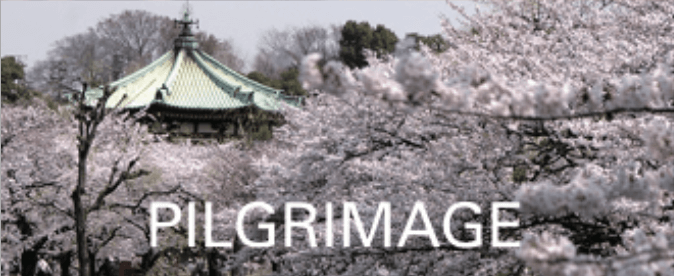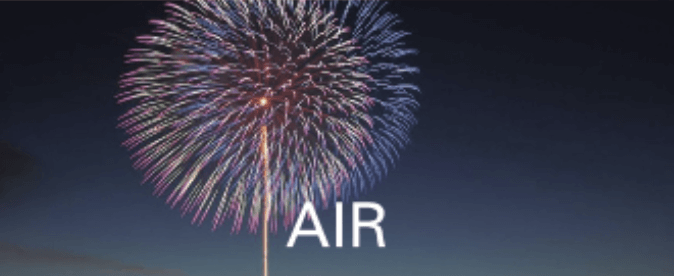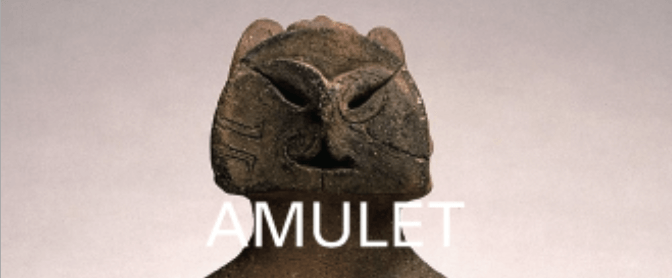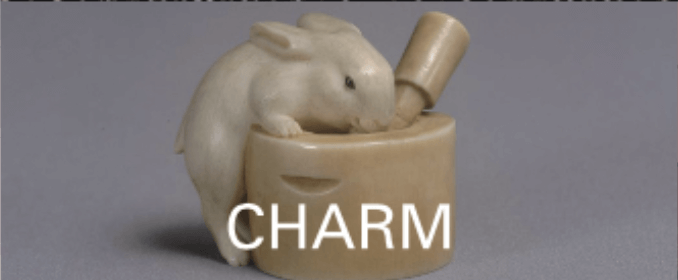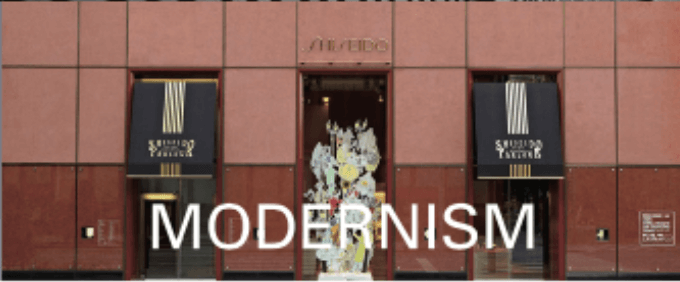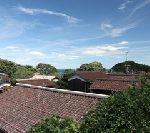
Kasa no misaki, a Cape that protrudes toward the Sea of Japan on the Kaga coast. It is a sea cliff with large and small islets scattered at the tip of the cape and a perfect scenic spot to open to the Sea of Japan to the left and right. The contrast between the chalky light house and the azure sea is beautiful.
Hashidate Town built wealth through the trade of Kitamae-bune, cargo ships that sailed the Japanese Sea, between Ezo, Hokkaido and Osaka, during the Edo period (1603 – 1868), and the Meiji period (1868 – 1912). This town was known as the wealthiest village in Japan, which was lined with the shipowners’ houses. The remnant of the wealthy village still remains.
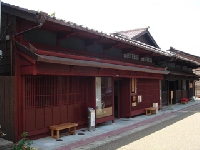
Mikuni Town had been developed by the Trade of Kitamae-bune, cargo ships, which sailed the Japan Sea between Ezo, Hokkaido and Osaka, during the Edo period (1603 – 1868). The town was supported and guarded by the Fukui Domain. The Town also developed craft techniques, such as Mikuni Tansu, a chest of drawers, which was known as Funadansu, a chest made for the protection of fragile items in the turbulent seas.
In the streetscape lined with emotional lattice doors, the former residence of the Kishina family is open to the public. It was built in 1823 by Kishina Sosuke, the owner of Shinboya, a lumber wholesaler. The power of floating lumber made the history.

Mikuni Town is at the mouth of the Kuzuryu River that pours into the Sea of Japan. Its streetscape has an emotional atmosphere, in the contrast with the atmosphere of Tojinbo, which has dynamic scenery of cliffs and rock formations. It had flourished as a port for a long time, including the Trade of Kitamae-bune, cargo ships that sailed the Japan Sea, between Ezo, Hokkaido and Osaka, during the Edo period (1603 – 1868).
It had developed the craft techniques, such as Mikuni Tansu, a chest of drawers, which was known as Funadansu, a chest made for the protection of fragile items in the turbulent seas.
You can enjoy the streetscapes with the beauty of early modern times and modern beauty, such as houses with vermilion colored lattice doors, and the former bank’s headquarters building, with its Western-style architecture.
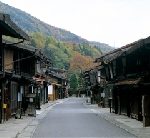
Narai is the 34th post town of Nakasendo Rokujyukyu Tsugi, Sixty-nine stops on the Nakasendo, the route connecting Kyoto and Edo in the Edo period. It has the highest altitude in Kiso Juichishuku, 11 post towns in Kiso district on Nakasendo.
The post town is next to Toriitoge Pass, which was the most difficult area to travel along the Nakasendo, and the woodwork of Magemono, a round-shaped Japanese box made of thin strips of wood, comb and lacquer ware thrived.
This post town was the western entrance to Kyoto. It was famous as Narai Senken, the thousand buildings of Narai. meaning it flourished as a post town, which was characterized by the structure of the eaves that protruded along the road.
The townscape included Hatago, inns, with Kento, lanterns hanging on its eaves. And Senbongoshi, a lattice of evenly spaced vertical timber, which provided a dignity to the town, while the arched bridge made of 300-year-old Kiso Hinoki (Japanese cypress), with no stanchions, has a deep lyricism.
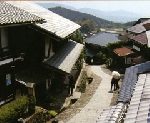
Magome post town was located between Tsumago post town, in Shinano Province Nagano and Mino Province, on the Nakasendo, the route connecting Kyoto and Edo in the Edo period. In Honjin, a lodging for a feudal lord during the Edo period, private houses, a temple and a shrine, to prepare for the commutation of alternate attendance style by feudal lords for the Edo Shogunate and the courtiers in Kyoto, in the Edo period (1603 – 1868).
Shimazaki Toson (1872 – 1943), a Japanese author, was born at this post town, where stone walls were built on both sides of street on the hill for building residences. Toson Memorial Hall is at the residence of a family that served Honjin as a wholesale dealer and village headman. Today, the courtyard still has the foundation stones of Honjin, and traces of a fireproof building.
You can see the forest of Eishouji temple, from the courtyard, which is the family temple of the Shimazaki family.

There are a group of white earthen-walled storehouses, with red roof tiles and black wainscots along the Tamagawa River, flowing through the city. A stone bridge with a slight curve is laid between the storehouse and the merchant house, creating a beautiful scenery.
Yabase Ourai Kaido Road, is the road that led to Kurayoshi, since the Nara period (710 – 794), and was surveyed by Ino Tadataka (1745 – 1818), a Japanese surveyor and cartographer. This road retains the path where Tadataka walked about 200 years ago. The path is also the tradition and culture of Kurayoshi, which had flourished as a commercial city.
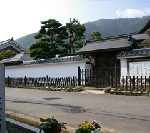
In the area of Furumachi at Ohara shuku, post town, transportation by Takasebune, flatboat through the Yoshii River had been active since the Age of Provincial Wars in the 15th – 16th centuries. After this area became Shogun demesne in the Edo period (1603 – 1868), Furumachi prospered as a collection and distribution center. Merchants’ warehouses were lined up around the docks. Daimyo Gyoretsu, the feudal lords procession for the Edo Shogunate, passed through Inaba kaido roads. These roads connected Himeji in the Seto Inland Sea, Mimasaka, and Tottori in the Japan Sea. Ohara shuku, was the only one post town in Sakushu, Mimasaka Province. Ohara shuku is also nearby Sakushu Miyamoto Village, which was the hometown of Miyamoto Musashi (1584 – 1645), a great Japanese swordsman, writer and painter.
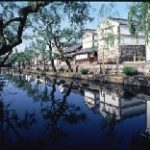
Kobori Enshu (1579 – 1647), a feudal lord, a master of the tea ceremony, an architect and garden designer, was a local magistrate of Bichu Matsuyama Domain and Kurashiki, during the winter campaign of the siege of Osaka in 1614.
Enshua sent a large Hyoromai, provisions of rice for the army, to the Tokugawa Shogunate side. After the campaign, Kurashiki became a Shogun demesne, in 1642, and flourished as the commercial place, where rice, cotton, and oil from Bichu, Mimasaka, Sanuki Provice, was gathered and transported via land and waterways.
Warehouses for cotton, rice and manure wholesalers were built along the river, and the Ohara family became a leading merchant who operated cotton brokers and rice wholesalers.
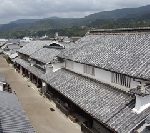
Hachisuka Awa Domain encouraged indigo plantations for Osaka and the Kinai region, provinces surrounding Kyoto and Nara, during the Edo period (1603 – 1868). Merchants of indigo and kimono, Japanese traditional clothes, developed and prospered in this area, which was blessed with the water transport of the Yoshino River.
The prosperity remains in the streetscape here. It features the eaves of the large tiled roofs along the line of houses and the walls of thick plaster and plaster-finished Udatsu, lavishly decorated short pillars set on a beam to support a ridgepole. These were symbols of wealth and success.
In life here, local production in business and decorative arts were not divided.
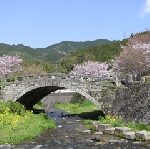
Meganebashi, a two-arched bridge at Akizuki, Asakura City was built in 1810. The historic Akizuki Castle Town dates back to 1203, with the Akizuki clan, who is said to be the descendant of the Chinese Emperor of the Han Dynasty. The Akizuki clan had moved to Takanabe, Miyazaki, after the conquest of Toyotomi Hideyoshi (1537 – 1598), the powerful feudal lord and Imperial Regent who unified Japan.
Even after the Akizuki clan moved out, Akizuki Castle Town was maintained well by the branch Domain of Kuroda Domain, Fukuoka, who was passed on the insight from Akizuki clan. This castle town was mentioned as a little Kyoto, with the tasteful townscape.
It conveys the history that the beauty of insight had been cultivated here as centered on the clan school, Keikokan.
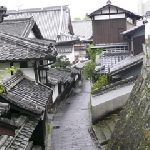
Usuki had prospered as a castle town until the Meiji Restoration, in 1868: event that sectored practical imperial rule of the Empire of Japan under Emperor Meiji. Nioza is the district where a lot of ruins of samurai residences, with large gate and white-walled fireproof buildings, stand in a row. The Stone pavement is in harmony with the white plaster walls on the stone walls.
This district was originally a tuff hill, made of the volcanic ash of Mt. Aso. The rocks were shaved and the roads passed through. Those are called Kiritoshi, street cut through hilly terrain. Kiritoshi, in front of Kyu Shinkoji, a former Shinkoji temple, is a representative scene of Usuki.
You take a breath in its appearance.
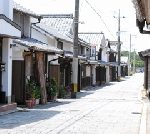
Mimitsu has the legend of Jinmu Tosei, the Eastern expedition of the first Emperor Jimnu, who departed from Mifune, which became the commercial port of Takanabe Domain in the Edo period (1603 – 1868), in the early modern times. Sengoku Bune, a large junk boat with capacity for 1,000 koku, a unit of volume of rice, arrived in Mimitsu, loaded with wood transported through the Mimikawa River, and headed to Osaka.
It is said that a number of houses and stores of shipping agencies and traders lined up. It was called Mimitsu Senken, Mimitsu of 1,000 buildings means a flourishing town, until the Meiji Restoration, an event that sectored practical imperial rule of the Empire of Japan in 1868, under Emperor Meiji.
The townscape still remains tasteful and traditional, where Kyogoshi, a thinner lattice of Kyoto townhouses, and white walls, stand in a row.
